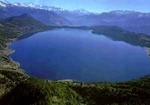RARA NATIONAL PARK
In the magnificent Himalayas of Nepal, there’s a small protected area occupying forty one meters of Mugu and Dolpa districts. It is the smallest national park of Nepal which was established in 1976 aiming for the protection the unique flora and fauna of Humla and Jumla regions of Nepal. It’s is governed by the Department of National Parks and wildlife Conservation, Ministry of Forests.
This National Park provides shelter to 170 species of flora. The major floras are Rhododendron, fir, brown oak, Blue Pine, Black Juniper and Himalayan Cypress. Above 3200 meters, coniferous forest consisting of a mixture of fir, pine and spruce are abundant.
Among the fauna, 51 species of mammals, 241 species of birds, two species of reptiles and amphibians along with three species of fish can be found here. Musk deer, Himalayan tahr, Himalayan black bear, Yellow throated Marten and Rhesus Macaque are the most spotted animals here. Among the birds, coots are found in the lake while in the winter, Great crested and Black necked grebes, Red crested Pochards, Himalayan Snowcock, Kalij Pheasant and Blood Pheasants fly here.
Apart from various species of flora and fauna, it’s major attachment is the Rara Lake which proudly occupies 10.8 kilometer square surface area, is 167 meters deep, five kilometers long and three kilometers wide. This alpine freshwater lake drains to Mugu-Karnali river through Nijar khola.
It is guarded in the southern side by the Chuchemara Peak while Ruma Kand and Malika Kand protect it from the northern side.
Now, just like every other good place, Rara National Park is difficult to get to. Visitors must take a flight from Kathmandu to Nepalgunj and fly again to Jumla or Kolti. Then, after a three day trek to the park office, we can reach there. There is also an alternate way where the visitors should travel from Nepalgunj to surkhet followed by a three day trek to the park.
The climate is pleasant in summer and freezing cold in the winter. April, May, September and October are the best months to visit.









